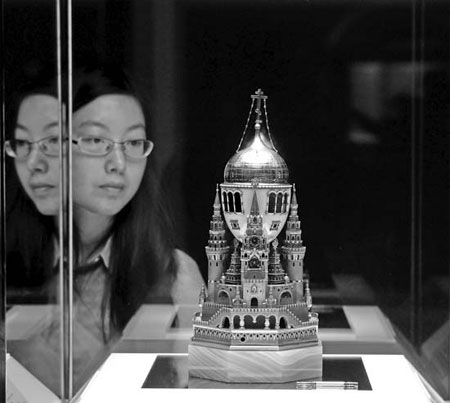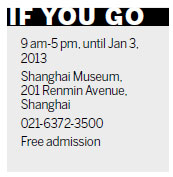

The Trans-Siberian Train Faberge egg was made in 1900 for Czar Nicholas II as an Easter gift to his wife. Gao Erqiang / China Daily
Treasures from the Kremlin Palace are on show in Shanghai, including four Faberge eggs.
The House of Faberge is a Russian jeweler founded by Gustav Faberge and carried on by his son, Peter Carl Faberge, in the mid 1800s.
The company is famous for its elaborate jewelry, especially the Faberge eggs created for the czars. This is the first time Faberge eggs have been exhibited in China.
The exhibition, titled World of Faberge, consists of more than 200 items, from the Kremlin Museum of Moscow and Fersman Mineralogical Museum of Russia.

House of Faberge created approximately 50 jewel-crusted Easter eggs for two czars, Alexander III and Nicolas II, and 42 of them have survived.
Kremlin Palace has 10 of the imperial Faberge eggs, which are the highlight of its collection, according to Elena Gagarina, general director of Kremlin Museum of Moscow.
Besides four of the imperial Faberge eggs, the exhibition presents a wide range of Faberge creations, from fine jewelry to ceremonial costumes, from religious icons to sculptures and royal house ware.
The four eggs on display are The Memory of Azov, featuring a miniature replica of the namesake Russian cruiser; The Trans-Siberian Train consisting of a five-carriage train with clockwork locomotive; The Moscow Kremlin in the shape of the Cathedral of the Assumption in Moscow; and the last Faberge egg, Constellation, which depicted the 12 signs of the zodiac, but was never finished because of the Russian revolution.
The Trans-Siberian Train was made in 1900 for Czar Nicholas II as an Easter gift to his wife. The egg has a surface of onyx, silver and gold, and decoration of enamel. Hidden inside is the surprise: a miniature train with vivid details. The five carriages were labeled with such names as "ladies only" and "prayer-room". A key can be inserted in the locomotive, to wind it up and make the train run.
Shanghai Museum made a huge effort to ensure the treasures are well presented.
"We had special glass cases designed for the eggs so that visitors can appreciate the treasured pieces from any angle," says Chen Xiejun, director of Shanghai Museum.
The exhibition is one of the major programs celebrating the 60th anniversary of Shanghai Museum. Shanghai people typically admire Russian culture and art, Chen says.
"Carl Faberge was not only a merchant and craftsman, but also an artist of originality," says the curator of the Kremlin Museum, Tatiana Muntian. "We've chosen the most representative pieces for audiences in Shanghai, as this is our first exhibition in China."
Kremlin Museum of Moscow has the largest collection of imperial Faberge eggs, and all but one of those on exhibition in Shanghai are from its collection.
The unfinished Constellation comes from Fersman Mineralogical Museum. Carl's son managed to secure the unfinished egg and later donated it to the museum, according to Victor Garanin, director of Fersman Mineralogical Museum.
Most of the other eggs are scattered in various museums in the United States, and three of them belong to the British Queen Elizabeth II.
zhangkun@chinadaily.com.cn